Although locally called The Stone Jetty it is actually a breakwater protecting the southern flank of Aberystwyth Harbour and faces westwards out in to the Irish Sea. The jetty is around 225-yards long and some 20-yards wide, but has no safety railings. This allows easy casting room, but care needs to be taken when fishing close to the edges in wet or frosty weather.
In south to southwest winds over force 4 the swell can break up the south side of the jetty and wash over the top, so take note of the weather conditions before starting to fish.
On the south side rocks were used in construction for the base, and these and reef ground extends out about 40 to 50yds away from the structure. This then gives on to clean sand with mixed ground in patches.
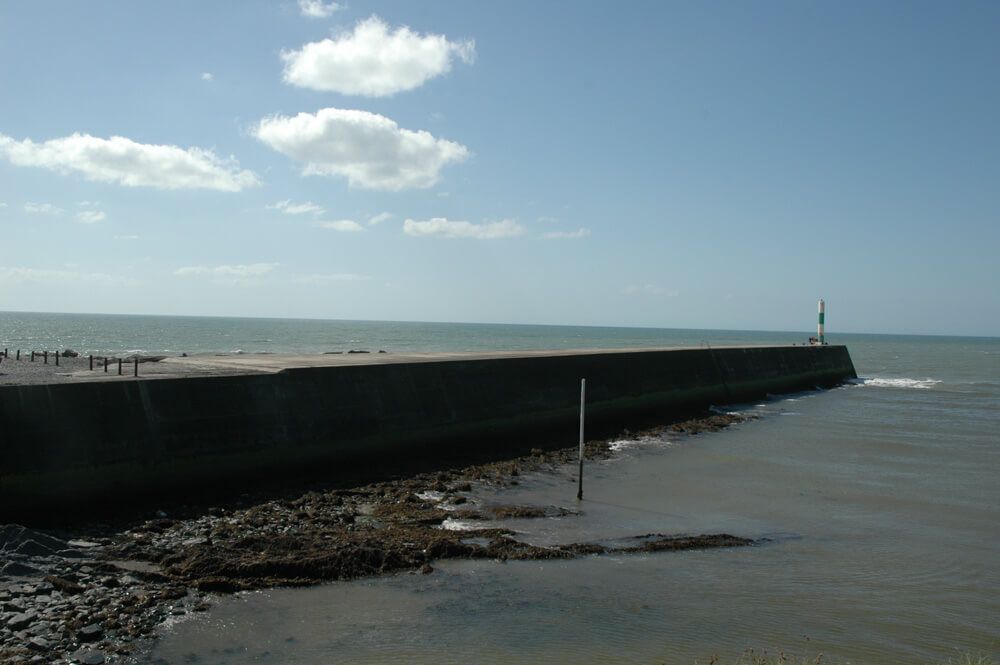
Casting from the end of the jetty at an angle out to the southwest clean sand gives way to rough ground at about 100yds. Straight out from end of the jetty at close range there is a shelf that drops down in to roughly 12ft of water over low tide on an average sized tide, with mixed rough ground straight out in front of you at range. Casting to the right side at an angle and towards Castle Rocks across the bay finds much heavier ground at range, with a flat concrete shelf tight in that drops off on to rough ground.
Standing in the middle section of the stone jetty on the north side and opposite the wooden jetty leading in to the harbour you can cast 40-yards out in to a deeper boat traffic channel with mainly clean ground amongst rock patches, but there is heavy rough in shallow water close in that you have to retrieve your gear over. Daytime boat traffic makes fishing difficult until the evenings.
Another good section is just above the beginning of the jetty where again after boat traffic has ceased for the day you can cast out in to the main deeper boat channel over cleaner ground to target fish moving in with the tide and in to the harbour. Swap sides here and you can cast out in to clean ground beyond a shingle backed beach with rocks in between.
THE SESSION
The session had had to be aborted twice already due to strong southerly winds and third time around it was still blowing a good south by southwest force 5. In these conditions from mid flood tide to three hours on the ebb the swell can break over the jetty, so the session had to be fished the three hours down to low water, just to be on the safe side.
The sea was chocolate coloured with clumps of floating weed on the surface after three days of howling wind and local angler Darren Wragg and I were to team up, we didn’t rate our chances good as we got the gear together, especially as the live rag we wanted wasn’t available either.
Recent catches had been just the odd dogfish, rockling, pouting and poor cod, but with the season being a late one hereabouts there was still the chance of dabs and whiting.
We chose the end of the pier, but fishing the south side where a cast straight in to the teeth of the wind would put us on to clean sand. I was also hoping to bang a long cast out on to rougher ground to the right, but surfers and canoeists working the waves there put the idea in to touch.
Darren tackled up with a one hook clipped down rig and biggish bait consisting of black lug and sandeel. This was banged out on to the sand, but his second rod was to be fished casting back in towards the harbour and in to the boat traffic channel with flounder and eels in mind.
I took a different approach, opting for a two-hook clipped down rig with size 2 Aberdeen’s for fishing the sand aiming to maximise my chance of species figuring smaller baits would take the dogs, but also pick up any flatties and whiting working the ground. A second rod though, with a short three hook rig and small hooks would be dropped in close right amongst the boulders and rocks used to form the jetty foundations aiming to pick up any small mini species that were able to withstand the deep and heavy swell breaking over the jetty’s base.
Carefully checking our reel magnet controls with the strong wind in mind, we were able to work at ranges up to about 90yds, with us both electing to go long at first, and then dropping shorter if bites failed to arrive.
Bites were difficult to detect in the wind, but I was first in with a shanny that picked up a tiny scrap of lug and even though I had released a little slack line to get the baits tighter to the seabed in the high swell, it was the bottom hook fixed tight above the lead that took the fish.
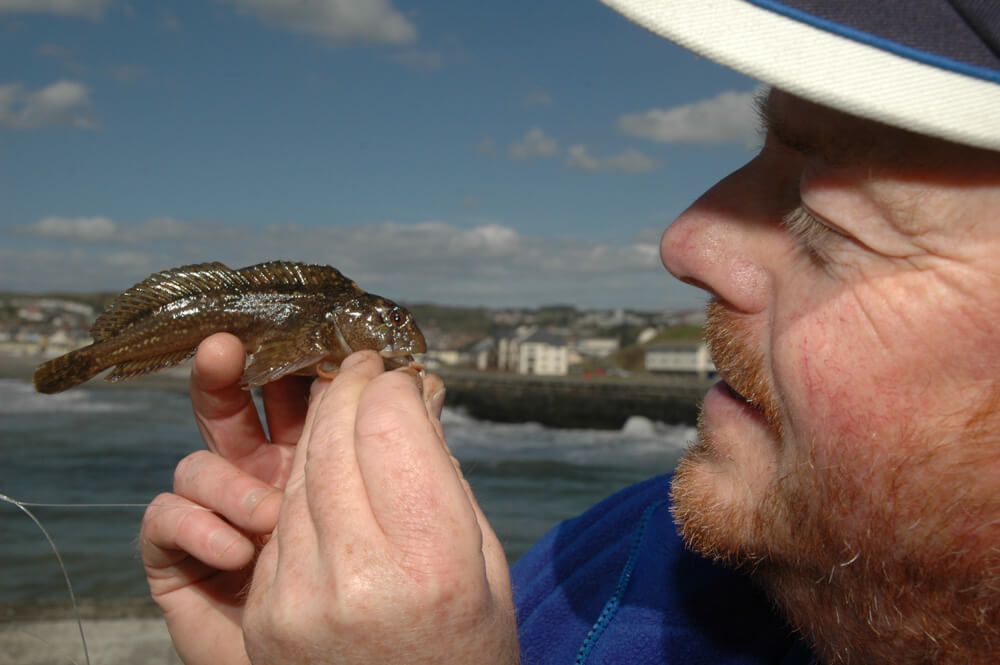
Darren was quick to follow with a gentle double pull down on the rod tip and quick reaction strike that resulted in a dogfish. At least we had avoided a blank!
I picked up a double header of doggies, then we both starting to look at working with the variety of baits we’d got to try and winkle out any other species that might be within range. Carrying frozen mackerel, sandeel, crab, lug and squid gave us plenty of combos, but missing that live rag wouldn’t help.
Going through the bait combinations I quickly realised that even the dogs were being choosy and bites were coming quicker to the frozen back lug. So, leaving the lug in the wrappers, I went for squid and mackerel strips trying to winkle out a dab, but inevitably after time the dogs found these baits too.
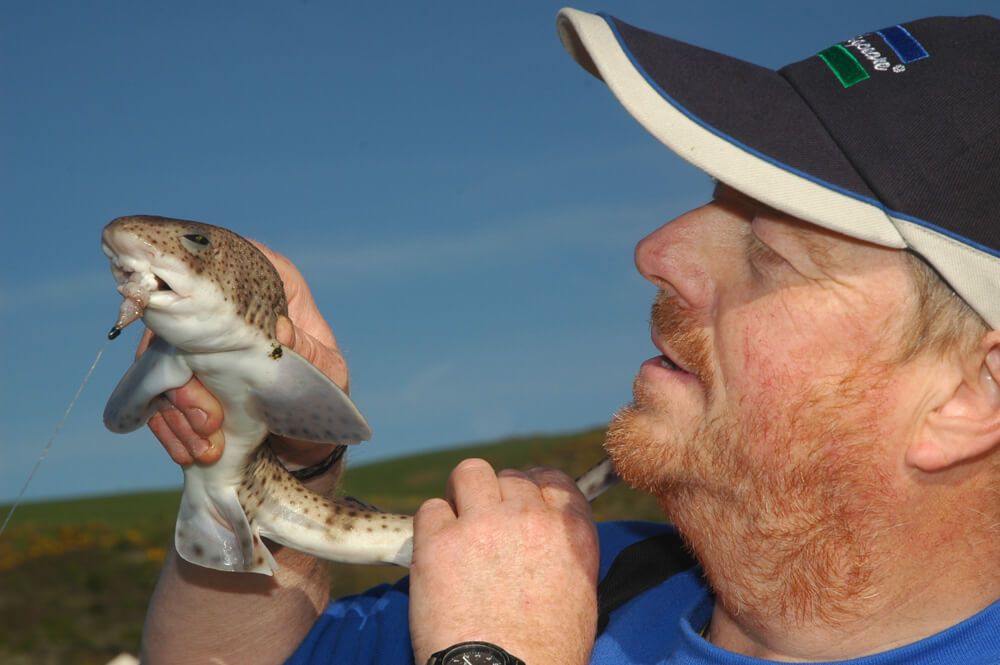
The harbour channel hadn’t produced any bites at all, so Darren began fishing his two rods out on the southern side. He was also thinking that the smaller hooks might just find something different. A double header of dogfish was a quick pay back.
As the depth decreased with the tide ebbing, the swell now became a heavy surf that washed round the end of the jetty. Leaving one rod in the rest to fish alone, I systematically worked the smaller baits around the end of the jetty covering as much ground as possible hoping for a corkwing wrasse, which can be plentiful here a little later in the season. This tactic only enjoyed small success with only another shanny taken on a crab leg.
There was a lull in bites and we sat side by side discussing what the jetty can produce in the right conditions. The south side has produced a string of big bass through recent summers including a couple of fish over 10lbs. The plug anglers were also taking good bass to 7lbs during July and August of 2005. Fishing out on to the cleaner ground can also see a few grey and tub gurnards taken, gurnards being a fairly rare catch for a shore angler in most areas of the UK.
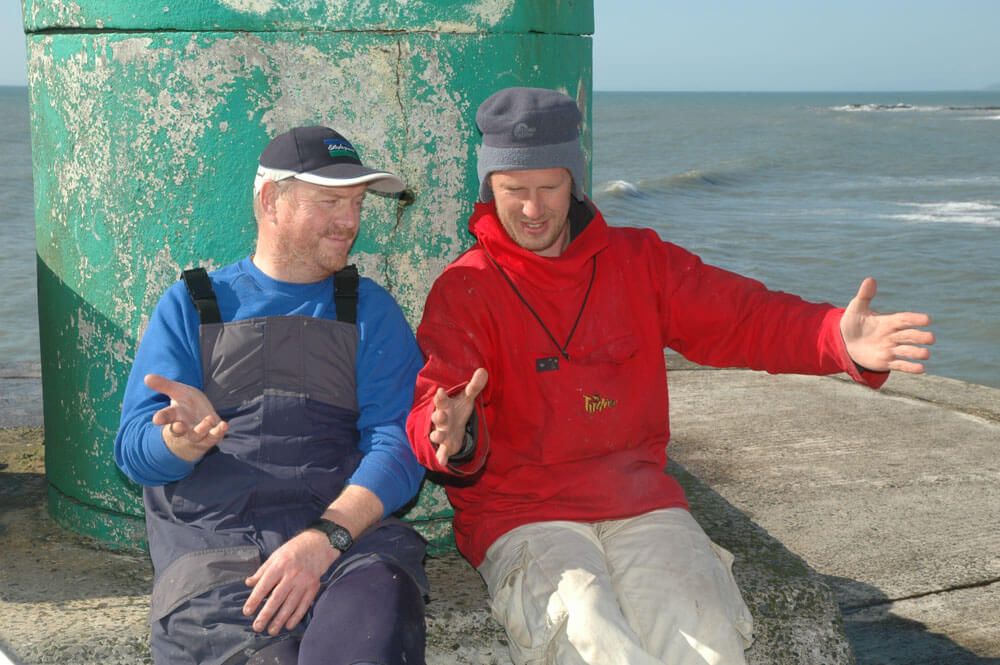
As low water came the dogs came on thick and fast, both of us getting more double headers amongst single fish. I tried one last trick swapping over from a grip lead to a plain flat lead and “feeling” my baits in off the sand to lie on the junction of the rock and reef just beyond the jetty, but only had more dogfish.
Both of us had covered as much of the available ground in front of us as possible trying to seek out little pockets of dabs and whiting, but hard as we tried we couldn’t dink out any other species in the conditions. We fished on for an hour, but conscious of the wind picking up as the tide flooded, and the building swell, it was time to give it best.
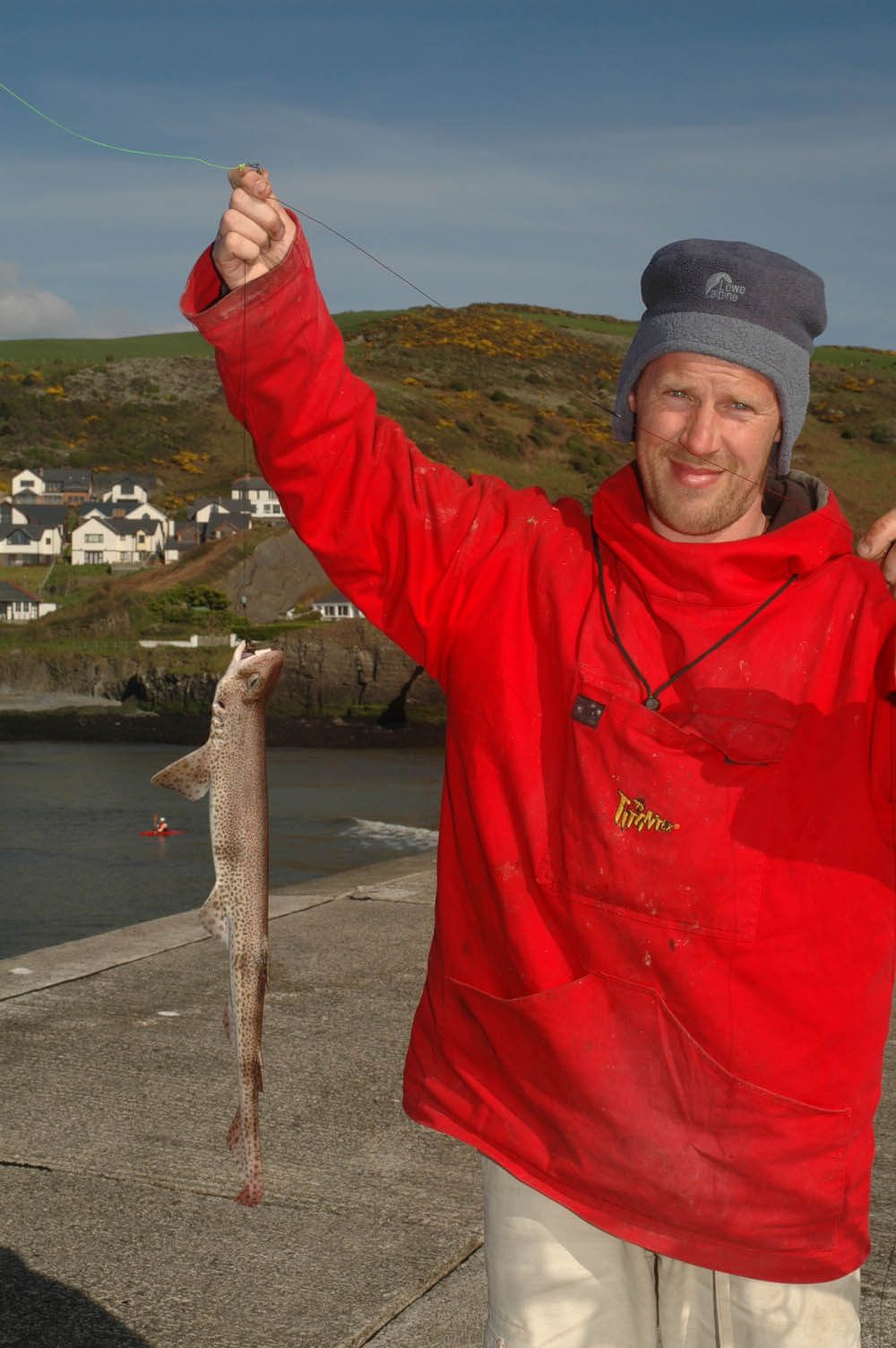
In reflection, after both Darren and myself not having felt very optimistic about our chances at the outset, a quick tot up suggested we’d lost count of the dogfish caught, plus the two shannies added a little variety. More species would have been nice, but in the conditions we figured we’d got it about right and we had both enjoyed a few hours fishing when most anglers would have been snug at home.
BEST TIMES TO FISH
Peak fishing time is from dead low water right through to high water, and maybe for the first hour of the ebb. You’ll still catch fish down the ebbing tide, but the fish tend to move out to longer range and the bigger casters do best at this time fishing on the south side casting out on to the cleaner sand.
It tends to fish to its best in a gentle south to southwest wind, with westerly winds good too. It produces well in daylight if there is a little colour in the sea, but if the sea is very clear after prolonged good weather stick to night fishing for the bottom feeding species.
Cold frosty nights can produce some really big bags of whiting, backed up by dabs, dogs, pout and poor cod, with the chance of codling in rougher seas casting out on to the rough ground during the spring tides in November and December.
WHAT YOU’LL CATCH
The huss tend to show from April through to Christmas, with small-eyed ray and thornbacks occasionally caught from the southern side of the jetty between late April through to late June, and showing again from late August to mid October.
Conger are present all year, mainly smaller fish to 10lbs, though near 20lbers have been recorded from the rough ground off the jetty end in previous seasons.
The bass come in early here, about mid April usually, peaking in numbers in June, but with the bigger fish resident from early September through to late October.
Garfish are the first summer species usually arriving in May, with mackerel taken from late June to September spinning and feathering. Mullet can be seen working the wall edges during this time period too.
The best of the channel flounder fishing is from September through to Christmas, with eels during the summer.
General species such as pouting, shore rockling, shannies, corkwing wrasse, pollack and smaller ballan wrasse are caught pretty much all year round, with September right through to February providing whiting, dabs, and in good years the occasional codling.
BAITS TO USE
Sandeel is a top bait for the huss and small-eyed rays, but does attract the dogfish too. Squid and mackerel are also good for the rays and huss and will pull out any conger as well. Also try dropping a fresh whole small whiting on to the sand or rough for these species.
Crab is the key spring time bait for the bass working down the sides, but switch to either a mackerel head or whole squid for the autumnal fish. A float fished blenny can also produce good bass during the summer months.
For the mini species in the rocks fish either small chunks of crab, crab legs or small sections of ragworm. Summer garfish and mackerel take small strips of mackerel or sandeel when float fishing.
Lugworm and rag work well for the dabs, whiting and winter flounder, but to pick out the better sized whiting tip the worm baits with sandeel or mackerel strip.
Try to have a good variety of baits with you and work through the combinations of baits to find the best formula on the day for the different target species.
When spinning always carry 1oz Dexter Wedges and Toby's in your lure box as these work especially well here. Regarding plug choice, then surface poppers such as the Chug Bug take a lot of fish, or try Rapala Slivers worked just sub surface.
TACTICS TO TRY
Pulley rigs made from 60lb mono with a single size 4/0 Mustad Viking hook is the top rig for the rays, huss and conger. Carry leads of 5 and 6ozs.
Over sand targeting the whiting, dabs and dogs a two-hook clipped down rig with size 2 Aberdeen hooks is ideal giving maximum range when needed. This rig also works well for the channel flounder and eels.
The mini species are best fished for using a mini three-hook flapper with size 6 to 10 hooks and tiny baits on 6lb to 12lb hook links, and use spark plugs or nuts and bolts as weights to cut tackle losses.
Fish for the garfish under bubble floats leaving 6ft between the float and hook. Use a 4ft section of 8lb Fluoro carbon line below the float to improve catches and keep the float moving to induce bites.
The mackerel take spinners or feathers, with black feathers at dusk the real bag fillers.
Work plugs and spinners over the rough ground on the south side either side of high water for the bass.
In south to southwest winds over force 4 the swell can break up the south side of the jetty and wash over the top, so take note of the weather conditions before starting to fish.
On the south side rocks were used in construction for the base, and these and reef ground extends out about 40 to 50yds away from the structure. This then gives on to clean sand with mixed ground in patches.

Casting from the end of the jetty at an angle out to the southwest clean sand gives way to rough ground at about 100yds. Straight out from end of the jetty at close range there is a shelf that drops down in to roughly 12ft of water over low tide on an average sized tide, with mixed rough ground straight out in front of you at range. Casting to the right side at an angle and towards Castle Rocks across the bay finds much heavier ground at range, with a flat concrete shelf tight in that drops off on to rough ground.
Standing in the middle section of the stone jetty on the north side and opposite the wooden jetty leading in to the harbour you can cast 40-yards out in to a deeper boat traffic channel with mainly clean ground amongst rock patches, but there is heavy rough in shallow water close in that you have to retrieve your gear over. Daytime boat traffic makes fishing difficult until the evenings.
Another good section is just above the beginning of the jetty where again after boat traffic has ceased for the day you can cast out in to the main deeper boat channel over cleaner ground to target fish moving in with the tide and in to the harbour. Swap sides here and you can cast out in to clean ground beyond a shingle backed beach with rocks in between.
THE SESSION
The session had had to be aborted twice already due to strong southerly winds and third time around it was still blowing a good south by southwest force 5. In these conditions from mid flood tide to three hours on the ebb the swell can break over the jetty, so the session had to be fished the three hours down to low water, just to be on the safe side.
The sea was chocolate coloured with clumps of floating weed on the surface after three days of howling wind and local angler Darren Wragg and I were to team up, we didn’t rate our chances good as we got the gear together, especially as the live rag we wanted wasn’t available either.
Recent catches had been just the odd dogfish, rockling, pouting and poor cod, but with the season being a late one hereabouts there was still the chance of dabs and whiting.
We chose the end of the pier, but fishing the south side where a cast straight in to the teeth of the wind would put us on to clean sand. I was also hoping to bang a long cast out on to rougher ground to the right, but surfers and canoeists working the waves there put the idea in to touch.
Darren tackled up with a one hook clipped down rig and biggish bait consisting of black lug and sandeel. This was banged out on to the sand, but his second rod was to be fished casting back in towards the harbour and in to the boat traffic channel with flounder and eels in mind.
I took a different approach, opting for a two-hook clipped down rig with size 2 Aberdeen’s for fishing the sand aiming to maximise my chance of species figuring smaller baits would take the dogs, but also pick up any flatties and whiting working the ground. A second rod though, with a short three hook rig and small hooks would be dropped in close right amongst the boulders and rocks used to form the jetty foundations aiming to pick up any small mini species that were able to withstand the deep and heavy swell breaking over the jetty’s base.
Carefully checking our reel magnet controls with the strong wind in mind, we were able to work at ranges up to about 90yds, with us both electing to go long at first, and then dropping shorter if bites failed to arrive.
Bites were difficult to detect in the wind, but I was first in with a shanny that picked up a tiny scrap of lug and even though I had released a little slack line to get the baits tighter to the seabed in the high swell, it was the bottom hook fixed tight above the lead that took the fish.

Darren was quick to follow with a gentle double pull down on the rod tip and quick reaction strike that resulted in a dogfish. At least we had avoided a blank!
I picked up a double header of doggies, then we both starting to look at working with the variety of baits we’d got to try and winkle out any other species that might be within range. Carrying frozen mackerel, sandeel, crab, lug and squid gave us plenty of combos, but missing that live rag wouldn’t help.
Going through the bait combinations I quickly realised that even the dogs were being choosy and bites were coming quicker to the frozen back lug. So, leaving the lug in the wrappers, I went for squid and mackerel strips trying to winkle out a dab, but inevitably after time the dogs found these baits too.

The harbour channel hadn’t produced any bites at all, so Darren began fishing his two rods out on the southern side. He was also thinking that the smaller hooks might just find something different. A double header of dogfish was a quick pay back.
As the depth decreased with the tide ebbing, the swell now became a heavy surf that washed round the end of the jetty. Leaving one rod in the rest to fish alone, I systematically worked the smaller baits around the end of the jetty covering as much ground as possible hoping for a corkwing wrasse, which can be plentiful here a little later in the season. This tactic only enjoyed small success with only another shanny taken on a crab leg.
There was a lull in bites and we sat side by side discussing what the jetty can produce in the right conditions. The south side has produced a string of big bass through recent summers including a couple of fish over 10lbs. The plug anglers were also taking good bass to 7lbs during July and August of 2005. Fishing out on to the cleaner ground can also see a few grey and tub gurnards taken, gurnards being a fairly rare catch for a shore angler in most areas of the UK.

As low water came the dogs came on thick and fast, both of us getting more double headers amongst single fish. I tried one last trick swapping over from a grip lead to a plain flat lead and “feeling” my baits in off the sand to lie on the junction of the rock and reef just beyond the jetty, but only had more dogfish.
Both of us had covered as much of the available ground in front of us as possible trying to seek out little pockets of dabs and whiting, but hard as we tried we couldn’t dink out any other species in the conditions. We fished on for an hour, but conscious of the wind picking up as the tide flooded, and the building swell, it was time to give it best.

In reflection, after both Darren and myself not having felt very optimistic about our chances at the outset, a quick tot up suggested we’d lost count of the dogfish caught, plus the two shannies added a little variety. More species would have been nice, but in the conditions we figured we’d got it about right and we had both enjoyed a few hours fishing when most anglers would have been snug at home.
BEST TIMES TO FISH
Peak fishing time is from dead low water right through to high water, and maybe for the first hour of the ebb. You’ll still catch fish down the ebbing tide, but the fish tend to move out to longer range and the bigger casters do best at this time fishing on the south side casting out on to the cleaner sand.
It tends to fish to its best in a gentle south to southwest wind, with westerly winds good too. It produces well in daylight if there is a little colour in the sea, but if the sea is very clear after prolonged good weather stick to night fishing for the bottom feeding species.
Cold frosty nights can produce some really big bags of whiting, backed up by dabs, dogs, pout and poor cod, with the chance of codling in rougher seas casting out on to the rough ground during the spring tides in November and December.
WHAT YOU’LL CATCH
The huss tend to show from April through to Christmas, with small-eyed ray and thornbacks occasionally caught from the southern side of the jetty between late April through to late June, and showing again from late August to mid October.
Conger are present all year, mainly smaller fish to 10lbs, though near 20lbers have been recorded from the rough ground off the jetty end in previous seasons.
The bass come in early here, about mid April usually, peaking in numbers in June, but with the bigger fish resident from early September through to late October.
Garfish are the first summer species usually arriving in May, with mackerel taken from late June to September spinning and feathering. Mullet can be seen working the wall edges during this time period too.
The best of the channel flounder fishing is from September through to Christmas, with eels during the summer.
General species such as pouting, shore rockling, shannies, corkwing wrasse, pollack and smaller ballan wrasse are caught pretty much all year round, with September right through to February providing whiting, dabs, and in good years the occasional codling.
BAITS TO USE
Sandeel is a top bait for the huss and small-eyed rays, but does attract the dogfish too. Squid and mackerel are also good for the rays and huss and will pull out any conger as well. Also try dropping a fresh whole small whiting on to the sand or rough for these species.
Crab is the key spring time bait for the bass working down the sides, but switch to either a mackerel head or whole squid for the autumnal fish. A float fished blenny can also produce good bass during the summer months.
For the mini species in the rocks fish either small chunks of crab, crab legs or small sections of ragworm. Summer garfish and mackerel take small strips of mackerel or sandeel when float fishing.
Lugworm and rag work well for the dabs, whiting and winter flounder, but to pick out the better sized whiting tip the worm baits with sandeel or mackerel strip.
Try to have a good variety of baits with you and work through the combinations of baits to find the best formula on the day for the different target species.
When spinning always carry 1oz Dexter Wedges and Toby's in your lure box as these work especially well here. Regarding plug choice, then surface poppers such as the Chug Bug take a lot of fish, or try Rapala Slivers worked just sub surface.
TACTICS TO TRY
Pulley rigs made from 60lb mono with a single size 4/0 Mustad Viking hook is the top rig for the rays, huss and conger. Carry leads of 5 and 6ozs.
Over sand targeting the whiting, dabs and dogs a two-hook clipped down rig with size 2 Aberdeen hooks is ideal giving maximum range when needed. This rig also works well for the channel flounder and eels.
The mini species are best fished for using a mini three-hook flapper with size 6 to 10 hooks and tiny baits on 6lb to 12lb hook links, and use spark plugs or nuts and bolts as weights to cut tackle losses.
Fish for the garfish under bubble floats leaving 6ft between the float and hook. Use a 4ft section of 8lb Fluoro carbon line below the float to improve catches and keep the float moving to induce bites.
The mackerel take spinners or feathers, with black feathers at dusk the real bag fillers.
Work plugs and spinners over the rough ground on the south side either side of high water for the bass.

